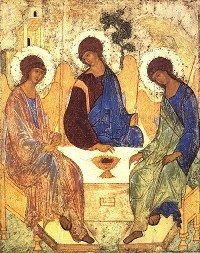Feast Day of St. John the Baptist
Isaiah 40: 1-11
Acts 13:14b-26
Luke 1:57-80

In what follows, I am going to depart from the usual way in which responsible expository preachers are supposed to preach sermons. I am not going to focus primarily on the meaning of the biblical texts themselves. Rather, I am going to look at the slightly different question of how it is that we as Christians make sense of the texts, how it is that the church has read these particular texts, and particularly the text in Isaiah. Because, frankly, there is a bit of a problem.
Let me explain what I mean by referring to an icon called The Hospitality of Abraham, that shows three angels sitting around a table. (For backround, see Solrunn Ness, The Mystical Language of Icons, (Grand Rapids: Eerdmans, 2005), pp.36-37) It is based on the story from Genesis 18 in which three men appear to Abraham, and Abraham offers the men hospitality. There are some odd details about the story. The narrative begins by stating that The LORD appeared to Abraham by the oaks of Mamre, and throughout the narrative Abraham speaks to one of the visitors, who promises Abraham that he will have a son, and later he and Abraham have a long discussion about whether or not Sodom is going to be destroyed. Throughout the narrative, this visitor who speaks with Abraham is referred to as the LORD.
The icon has a second name. It is also called “The Old Testament Trinity,” and the Eastern Church in particular has identified these three visitors with the divine Trinity. John of Damascus says: “Abraham did not see the divine nature, for no one has ever seen God, but he saw an image of God and fell down and worshiped.” (See John of Damascus, On Holy Images, part 3, ch. 4.) In the icon, the figure on the left is identified with the Father; the figure on the middle is identified with the pre-existent Word or Logos. The one on the right is identified with the Holy Spirit. (more…)


